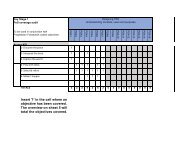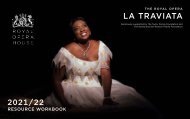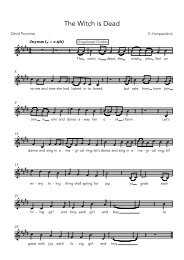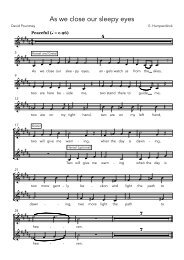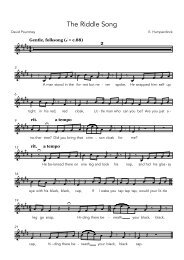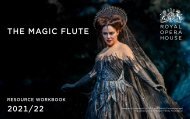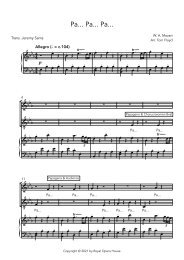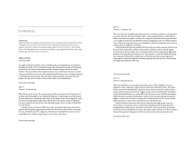Design and Technology progression framework KS1-2
Create successful ePaper yourself
Turn your PDF publications into a flip-book with our unique Google optimized e-Paper software.
<strong>Design</strong> <strong>and</strong> <strong>Technology</strong> Progression Framework – NC2014 PoS – Coded Objectives (Primary)<br />
PDA -<br />
DESIGNING<br />
Underst<strong>and</strong>ing<br />
contexts, users<br />
<strong>and</strong> purposes<br />
Across <strong>KS1</strong> Lower KS2 Upper KS2 Across KS2<br />
PDA 1 - work confidently within a range of<br />
contexts, such as imaginary, story-based,<br />
home, school, gardens, playgrounds, local<br />
community, industry <strong>and</strong> the wider<br />
environment<br />
PDA 2 - state what products they are<br />
designing <strong>and</strong> making<br />
PDA 3 - say whether their products are for<br />
themselves or other users<br />
PDA 4 - describe what their products are<br />
for<br />
PDA 5 - say how their products will work<br />
PDA 6 - say how they will make their<br />
products suitable for their intended users<br />
PDA 7 - use simple design criteria to help<br />
develop their ideas<br />
PDA 8 - gather information about the<br />
needs <strong>and</strong> wants of particular<br />
individuals <strong>and</strong> groups<br />
PDA 9 - develop their own design<br />
criteria <strong>and</strong> use these to inform their<br />
idea<br />
PDA 10 - carry out research, using<br />
surveys, interviews, questionnaires<br />
<strong>and</strong> web-based resources<br />
PDA 11 - identify the needs, wants,<br />
preferences <strong>and</strong> values of particular<br />
individuals <strong>and</strong> groups<br />
PDA 12 - develop a simple design<br />
specification to guide their thinking<br />
PDA13 - work confidently within a range<br />
of contexts, such as the home, school,<br />
leisure, culture, enterprise, industry <strong>and</strong><br />
the wider environment<br />
PDA 14 - describe the purpose of their<br />
products<br />
PDA 15 - indicate the design features of<br />
their products that will appeal to intended<br />
users<br />
PDA 16 - explain how particular parts of<br />
their products work<br />
PDB -<br />
DESIGNING<br />
Generating,<br />
developing,<br />
modelling <strong>and</strong><br />
communicating<br />
ideas<br />
PDB 1 - generate ideas by drawing on their<br />
own experiences<br />
PDB 2 - use knowledge of existing<br />
products to help come up with ideas<br />
PDB 3 - develop <strong>and</strong> communicate ideas<br />
by talking <strong>and</strong> drawing<br />
PDB 4 - model ideas by exploring<br />
materials, components <strong>and</strong> construction<br />
kits <strong>and</strong> by making templates <strong>and</strong> mockups<br />
PDB 5 - use information <strong>and</strong><br />
communication technology, where<br />
appropriate, to develop <strong>and</strong> communicate<br />
their ideas<br />
PDB 6 - generate realistic ideas,<br />
focusing on the needs of the user<br />
PDB 7 - make design decisions that<br />
take account of the availability of<br />
resources<br />
PDB 8 - generate innovative ideas,<br />
drawing on research<br />
PDB 9 - make design decisions,<br />
taking account of constraints such as<br />
time, resources <strong>and</strong> cost<br />
PDB 10 - share <strong>and</strong> clarify ideas through<br />
discussion<br />
PDB 11 - model their ideas using<br />
prototypes <strong>and</strong> pattern pieces<br />
PDB 12 - use annotated sketches, crosssectional<br />
drawings <strong>and</strong> exploded<br />
diagrams to develop <strong>and</strong> communicate<br />
their ideas<br />
PDB 13 - use computer-aided design to<br />
develop <strong>and</strong> communicate their ideas<br />
D&T Key Resources Progression Framework – NC2014 PoS coded objectives (Primary)1
PMA - MAKING<br />
Planning<br />
Across <strong>KS1</strong> Lower KS2 Upper KS2 Across KS2<br />
PMA 1 - plan by suggesting what to do<br />
next<br />
PMA 2 - select from a range of tools <strong>and</strong><br />
equipment, explaining their choices<br />
PMA 3 - select from a range of materials<br />
<strong>and</strong> components according to their<br />
characteristics<br />
PMA 4 - order the main stages of<br />
making<br />
PMA 5 - produce appropriate lists of<br />
tools, equipment <strong>and</strong> materials that<br />
they need<br />
PMA 6 - formulate step-by-step plans<br />
as a guide to making<br />
PMA 7 - select tools <strong>and</strong> equipment<br />
suitable for the task<br />
PMA 8 - explain their choice of tools<br />
<strong>and</strong> equipment in relation to the skills<br />
<strong>and</strong> techniques they will be using<br />
PMA 9 - select materials <strong>and</strong><br />
components suitable for the task<br />
PMA 10 - explain their choice of<br />
materials <strong>and</strong> components according to<br />
functional properties <strong>and</strong> aesthetic<br />
qualities<br />
PMB - MAKING<br />
Practical<br />
skills <strong>and</strong><br />
techniques<br />
PMB 1 - follow procedures for safety <strong>and</strong><br />
hygiene<br />
PMB 2 - use a range of materials <strong>and</strong><br />
components, including construction<br />
materials <strong>and</strong> kits, textiles, food ingredients<br />
<strong>and</strong> mechanical components<br />
PMB 3 - measure, mark out, cut <strong>and</strong> shape<br />
materials <strong>and</strong> components<br />
PMB 4 - assemble, join <strong>and</strong> combine<br />
materials <strong>and</strong> components<br />
PMB 5 - use finishing techniques, including<br />
those from art <strong>and</strong> design<br />
PMB 6 - measure, mark out, cut <strong>and</strong><br />
shape materials <strong>and</strong> components<br />
with some accuracy<br />
PMB 7 - assemble, join <strong>and</strong><br />
combine materials <strong>and</strong> components<br />
with some accuracy<br />
PMB 8 - apply a range of finishing<br />
techniques, including those from art<br />
<strong>and</strong> design, with some accuracy<br />
PMB 9 - accurately measure, mark out,<br />
cut <strong>and</strong> shape materials <strong>and</strong><br />
components<br />
PMB 10 - accurately assemble, join <strong>and</strong><br />
combine materials <strong>and</strong> components<br />
PMB 11 - accurately apply a range of<br />
finishing techniques, including those<br />
from art <strong>and</strong> design<br />
PMB 12 - use techniques that involve a<br />
number of steps<br />
PMB 13 - demonstrate resourcefulness<br />
when tackling practical problem<br />
PMB 14 - follow procedures for safety<br />
<strong>and</strong> hygiene<br />
PMB 15 - use a wider range of<br />
materials <strong>and</strong> components than <strong>KS1</strong>,<br />
including construction materials <strong>and</strong><br />
kits, textiles, food ingredients,<br />
mechanical components <strong>and</strong> electrical<br />
components<br />
D&T Key Resources Progression Framework – NC2014 PoS coded objectives (Primary)2
PEA -<br />
EVALUATING<br />
Own ideas<br />
<strong>and</strong> products<br />
Across <strong>KS1</strong> Lower KS2 Upper KS2 Across KS2<br />
PEA 1 - talk about their design ideas <strong>and</strong><br />
what they are making<br />
PEA 2- make simple judgements about<br />
their products <strong>and</strong> ideas against design<br />
criteria<br />
PEA 3 - suggest how their products could<br />
be improved<br />
PEA 4 - refer to their design criteria<br />
as they design <strong>and</strong> make<br />
PEA 5 - use their design criteria to<br />
evaluate their completed products<br />
PEA 6 - critically evaluate the quality<br />
of the design, manufacture <strong>and</strong><br />
fitness for purpose of their products<br />
as they design <strong>and</strong> make<br />
PEA 7 - evaluate their ideas <strong>and</strong><br />
products against their original design<br />
specification<br />
PEA 8 - identify the strengths <strong>and</strong><br />
areas for development in their ideas<br />
<strong>and</strong> products<br />
PEA 9 - consider the views of others,<br />
including intended users, to improve<br />
their work<br />
PEB -<br />
EVALUATING<br />
Existing products<br />
PEB 1 - what products are<br />
PEB 2 - who products are for<br />
PEB 3 - what products are for<br />
PEB 4 - how products work<br />
PEB 5 - how products are used<br />
PEB 6 - where products might be used<br />
PEB 7 - what materials products are made<br />
from<br />
PEB 8 - what they like <strong>and</strong> dislike about<br />
products<br />
PEB 9 - who designed <strong>and</strong> made<br />
the products<br />
PEB 10 - where products were<br />
designed <strong>and</strong> made<br />
PEB 11 - when products were<br />
designed <strong>and</strong> made<br />
PEB 12 - whether products can be<br />
recycled or reused<br />
PEB 13 - how much products cost to<br />
make<br />
PEB 14 - how innovative products<br />
are<br />
PEB 15 - how sustainable the<br />
materials in products are<br />
PEB 16 - what impact products have<br />
beyond their intended purpose<br />
PEB 17 - how well products have<br />
been designed<br />
PEB 18 - how well products have<br />
been made<br />
PEB 19 - why materials have been<br />
chosen<br />
PEB 20 - what methods of<br />
construction have been used<br />
PEB 21 - how well products work<br />
PEB 22 - how well products achieve<br />
their purposes<br />
PEB 23 - how well products meet<br />
user needs <strong>and</strong> wants<br />
PEC -<br />
EVALUATING<br />
Key events<br />
<strong>and</strong> individuals<br />
PEC 1- about inventors, designers,<br />
engineers, chefs <strong>and</strong> manufacturers<br />
who have developed ground-breaking<br />
products<br />
PTK - TECHNICAL<br />
KNOWLEDGE<br />
Making products<br />
work<br />
PTK 1 - about the simple working<br />
characteristics of materials <strong>and</strong><br />
components<br />
PTK 2 - about the movement of simple<br />
mechanisms such as levers, sliders,<br />
wheels <strong>and</strong> axles<br />
PTK 3 - how freest<strong>and</strong>ing structures can<br />
be made stronger, stiffer <strong>and</strong> more stable<br />
PTK 4 - that a 3-D textiles product can be<br />
assembled from two identical fabric<br />
shapes<br />
PTK 5 - that food ingredients should be<br />
combined according to their sensory<br />
characteristics<br />
PTK 6 - the correct technical vocabulary<br />
for the projects they are undertaking<br />
PTK 7 - how mechanical systems<br />
such as levers <strong>and</strong> linkages or<br />
pneumatic systems create<br />
movement<br />
PTK 8 - how simple electrical<br />
circuits <strong>and</strong> components can be<br />
used to create functional products<br />
PTK 9 - how to program a computer<br />
to control their products<br />
PTK 10 - how to make strong, stiff<br />
shell structures<br />
PTK 11 - that a single fabric shape<br />
can be used to make a 3D textiles<br />
product<br />
PTK 13 - how mechanical systems<br />
such as cams or pulleys or gears<br />
create movement<br />
PTK 14 - how more complex<br />
electrical circuits <strong>and</strong> components<br />
can be used to create functional<br />
products<br />
PTK 15 - how to program a computer<br />
to monitor changes in the<br />
environment <strong>and</strong> control their<br />
products<br />
PTK 16 - how to reinforce <strong>and</strong><br />
strengthen a 3D <strong>framework</strong><br />
PTK 17 - that a 3D textiles product<br />
can be made from a combination of<br />
fabric shapes<br />
PTK 19 - how to use learning from<br />
science to help design <strong>and</strong> make<br />
products that work<br />
PTK 20 - how to use learning from<br />
mathematics to help design <strong>and</strong><br />
make products that work<br />
PTK 21 - that materials have both<br />
functional properties <strong>and</strong> aesthetic<br />
qualities<br />
PTK 22 - that materials can be<br />
combined <strong>and</strong> mixed to create more<br />
useful characteristics<br />
PTK 23 - that mechanical <strong>and</strong><br />
electrical systems have an input,<br />
process <strong>and</strong> output<br />
D&T Key Resources Progression Framework – NC2014 PoS coded objectives (Primary)3
PCNA - COOKING<br />
AND NUTRITION<br />
Where food comes<br />
from<br />
PTK 12 - that food ingredients can<br />
be fresh, pre-cooked <strong>and</strong><br />
processed<br />
PTK 18 - that a recipe can be<br />
adapted by adding or substituting one<br />
or more ingredients<br />
Across <strong>KS1</strong> Lower KS2 Upper KS2 Across KS2<br />
PCNA 1 - that all food comes from plants<br />
or animals<br />
PCNA 2 - that food has to be farmed,<br />
grown elsewhere (e.g. home) or caught<br />
PCNA 3 - that seasons may affect<br />
the food available<br />
PCNA 4 - how food is processed into<br />
ingredients that can be eaten or used<br />
in cooking<br />
PTK 24 - the correct technical<br />
vocabulary for the projects they are<br />
undertaking<br />
PCNA 5 - that food is grown (such as<br />
tomatoes, wheat <strong>and</strong> potatoes),<br />
reared (such as pigs, chickens <strong>and</strong><br />
cattle) <strong>and</strong> caught (such as fish) in<br />
the UK, Europe <strong>and</strong> the wider world<br />
PCNB - COOKING<br />
AND NUTRITION<br />
Food preparation,<br />
cooking<br />
<strong>and</strong> nutrition<br />
PCNB 1 - how to name <strong>and</strong> sort foods into<br />
the five groups in The eatwell plate<br />
PCNB 2 - that everyone should eat at least<br />
five portions of fruit <strong>and</strong> vegetables every<br />
day<br />
PCNB 3 - how to prepare simple dishes<br />
safely <strong>and</strong> hygienically, without using a<br />
heat source<br />
PCNB 4 - how to use techniques such as<br />
cutting, peeling <strong>and</strong> grating<br />
PCNB 5 - that a healthy diet is<br />
made up from a variety <strong>and</strong> balance<br />
of different food <strong>and</strong> drink, as<br />
depicted in The eatwell plate<br />
PCNB 6 - that to be active <strong>and</strong><br />
healthy, food <strong>and</strong> drink are needed<br />
to provide energy for the body<br />
PCNB 7 - that recipes can be<br />
adapted to change the appearance,<br />
taste, texture <strong>and</strong> aroma<br />
PCNB 8 - that different food <strong>and</strong> drink<br />
contain different substances –<br />
nutrients, water <strong>and</strong> fibre – that are<br />
needed for health<br />
PCNB 9 - how to prepare <strong>and</strong> cook a<br />
variety of predominantly savoury<br />
dishes safely <strong>and</strong> hygienically<br />
including, where appropriate, the use<br />
of a heat source<br />
PCNB 10 - how to use a range of<br />
techniques such as peeling,<br />
chopping, slicing, grating, mixing,<br />
spreading, kneading <strong>and</strong> baking<br />
D&T Key Resources Progression Framework – NC2014 PoS coded objectives (Primary)4





